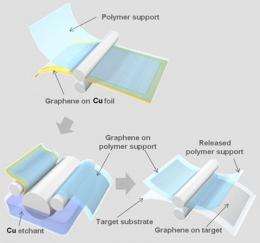June 21, 2010 report
Large sheets of graphene film produced for transparent electrodes (w/ Video)

(PhysOrg.com) -- Graphene is a relatively new material with outstanding electrical, chemical and mechanical properties that make it an attractive material for use as flexible conductors of the sort used in gadgets such as touch screens and flat panel TVs. In the past attempts to make large films of graphene have been unsuccessful, but now a team of scientists from South Korea and Japan have succeeded in roll-to-roll production of graphene films, growing them by chemical vapor deposition onto flexible copper substrates.
Graphene is composed of a single layer of carbon atoms in a honeycomb-shaped lattice. It was first isolated in 2004. The material is highly conductive, extremely strong, and is almost transparent, which makes it ideal for high-speed electronic devices.
The researchers grew their graphene sheets by chemical vapor deposition onto large sheets of copper foil. They coated the graphene with a thin layer of adhesive polymer and then dissolved away the copper backing. Using rollers, the graphene was then pressed against another substrate, such as PET, and the polymer layer was removed by heating, leaving a film of graphene. They repeated the process to produce a sheet of four layers of graphene on top of each other. This four-layer sheet was then treated with nitric acid to improve its electrical conductivity.

The rectangular sheets, which measured 76 cm on the diagonal, were of extremely high quality, with the four-layer stack of films exhibiting superior electrical resistance to commercially available transparent electrodes such as indium tin oxides (ITO). The films were almost transparent, allowing 90% of light to pass through.
The team, led by researchers Byung Hee Hong and Jong-Hyun Ahn of Sungkyunkwan University (SKKU) in Seoul, also incorporated their graphene electrodes into a fully functional touch-screen panel, where they outperformed standard indium tin oxide electrodes, withstanding double the strain that can be handled by the more fragile ITO. According to Ahn, a graphene-based touchscreen should essentially last forever.
Electronics companies have been looking for alternatives to ITO for some time because the indium is extremely expensive. Other options looked at have been films of carbon nanotubes, but these have not succeeded because they tend to have small defects that create visible areas of “dead” pixels in displays. Now that graphene has been manufactured in large sheets and demonstrated in real devices, it may only be a couple of years before graphene finds its way into consumer products.
Graphene is produced from a small amount of carbon, and unlike ITO production, uses no rare materials. The copper substrate is recyclable, which makes the process more sustainable.
The paper is published in the journal Nature Nanotechnology.
More information: Roll-to-roll production of 30-inch graphene films for transparent electrodes, Sukang Bae et al, Nature Nanotechnology advance online publication. Published online: 20 June 2010. doi:10.1038/nnano.2010.132
© 2010 PhysOrg.com




















